| Article ID | Journal | Published Year | Pages | File Type |
|---|---|---|---|---|
| 8626186 | International Journal of Developmental Neuroscience | 2016 | 37 Pages |
Abstract
Neonatal handling (H) and maternal separation (MS) both induce changes in maternal care, but the contribution of these changes to the behavioral and neurochemical outcomes of the offspring remains unclear, as studies often find opposite results concerning the frequency of maternal behaviors, particularly in the MS paradigm. In this study, behavior displayed by H, MS and non-handled (NH) Wistar rat dams were observed during the first 10Â days after birth. A tentative assessment of the quality of maternal care was made, using a previously reported score that reflects behavior fragmentation and inconsistency. Central oxytocin levels and hippocampal synaptic plasticity markers were also evaluated in dams, immediately after litter weaning. In adulthood, male and female offspring were subjected to a contextual stress-induced corticosterone challenge to provide further information on the impact of early interventions on neuroendocrine parameters. We found that while both H and MS interventions induced an increase in the amount of pup-directed behavior, MS dams displayed a more fragmented and inconsistent pattern of care, reflecting poorer maternal care quality. Interestingly, an increase in oxytocin levels was observed only in H dams. While H offspring did not differ from NH, MS males and females showed marked differences in corticosterone secretion compared to controls. Our results suggest that briefly removing the pups from the nest alters maternal care quantity but not quality and increases central oxytocin, while long separations appear to increase low quality maternal care and change neuroendocrine responses in adult offspring in a sex-specific manner.
Related Topics
Life Sciences
Biochemistry, Genetics and Molecular Biology
Developmental Biology
Authors
Natividade de Sá Couto-Pereira, Charles Francisco Ferreira, Carine Lampert, Danusa Mar Arcego, Ana Paula Toniazzo, Juliana Rombaldi Bernardi, Diego Carrilho da Silva, Eduardo Von Poser Toigo, Luisa Amalia Diehl, Rachel Krolow, PatrÃcia Pelufo Silveira,
